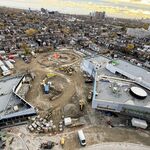smallspy
Senior Member
The Chargers in the new sets are equipped with sanders, so that's at least one point that's taken care of.I am curious how this will be done with the new fleet? As previously noted, the Chargers and Cab Cars will have a semi-permanent coupler at one end and a standard coupler at the other. That means an extra Charger locomotive can only be coupled nose to nose. I see three possible solutions:
As I have mentioned before, I suspect that the new fleet will operate with the Charger facing west when west of Montreal and facing east when east of Montreal. Central station has limited ventilation, and having the locomotive last to enter the station and first to leave would be beneficial.
- Put an extra charger locomotive at the back of the train (nose to nose). The locomotive would then need to be wyed at the end of the line, since the cab would be facing the wrong way,
- Replace the Cab Car with a locomotive. This would reduce capacity of the train and I am not sure if the semi-permanent couplers have a gender, which would prevent this.
- Seasonally add an F40PH-2 locomotive to the consist on trains that travel through Brantford.
And one of the things that VIA will be testing prior to the launch of service is how the new sets handle things like leaves on the track. While the first set that they've gotten won't be ready to test this years fallen leaves, there are other methods that they can use to simulate it for testing.
Another way is an operational procedure, much in the way you suspect that they will always operate cab-car-in at Central. Running with the loco pushing up grades where poor traction is known to happen can help prevent the train from stalling, as all of the wheels on the rail ahead of the propelling wheels will help clean the rail head.
I'm also surprised that they are doing heavy work on LRC's considering they will be retired in 2 years. (https://www.railpictures.net/photo/768224/)
That car was involved in a sideswipe collision just west of Kingston 2 years ago and received some structural damage at the vestibule on the other side of the car. I'm not sure if they are intending on repairing the car, or pulling it to bits to supply the rest of the fleet.
Dan





